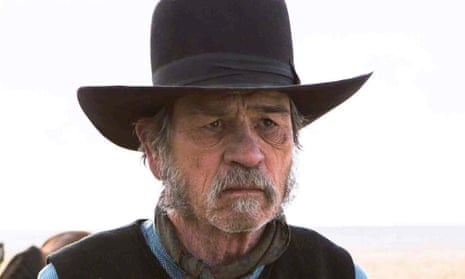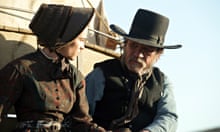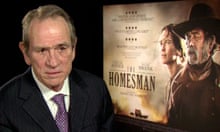If the western is always moribund but somehow never quite dead, then that’s probably down to two men: Walter Hill and Tommy Lee Jones. Hill directed the pilot of Deadwood and the miniseries Broken Trail, and has movies such as The Long Riders, Geronimo and Wild Bill to his name. He is the genre’s director emeritus, but Tommy Lee Jones is its modern-day face.
And what a face it is: that gnarled, acne-pocked, gin-blossomed lunar landscape of ornery venom and intermittent soulfulness, out of which comes that cantankerous Texan bark. It has graced the western for 25 years now, beginning with the epic Lonesome Dove and reappearing in The Missing, a pursuit western by Ron Howard; in the Coens’ neo-noir western No Country For Old Men; and in his own marvellous and strange directorial debut, set in the same brutal Tex-Mex borderlands, The Three Burials of Melquiades Estrada. And last time I checked, Jones still held the film rights to the Moby-Dick of modern western novels, Cormac McCarthy’s Blood Meridian, which has never yet found the Sam Peckinpah it needs. Give Jones credit: he is devoted to the genre, and spends half of the pay cheques from his larger, lesser movies on keeping it alive.
The Homesman, Jones’s third movie as a director (his second was The Sunset Limited, from a play by McCarthy, for HBO), is another unconventional western in that its focus is largely on women on the bleak and hostile Nebraska prairie just before the civil war. Hilary Swank is gentlewoman farmer Mary Bee Cuddy, a transplant from upstate New York who has built a successful holding but lacks a husband; men tell her she’s “plain and bossy”. After the harvest, she is commissioned by her church to transport three other women, all driven insane by the solitude of the pioneer homesteader’s life, to a minister’s wife in Iowa who will care for them. She takes on itinerant claim-jumper George Briggs (Jones), whom she saves from a lynching.
Nebraska was Willa Cather’s territory, and its austere beauty and minatory vastness suit Jones’s directorial temperament. The landscape tempers and dwarfs the characters, it teems with hostile Native Americans and predatory bandits, and takes forever to cross, especially as winter sets in. Cuddy is the civilised frontier embodied, with a farmhouse and a bank account, but even she can be pulled apart by the prairie’s huge skies and bitter winds and the loneliness beneath them.
In parts misshapen and unwieldy, but always surprising and deeply authentic, The Homesman confirms Jones’s gifts as a director, both of actors and spectacle, and reiterates, once again, his prodigious gifts as an actor. If he has to make another Men In Black to finance more westerns, I won’t complain.









Comments (…)
Sign in or create your Guardian account to join the discussion